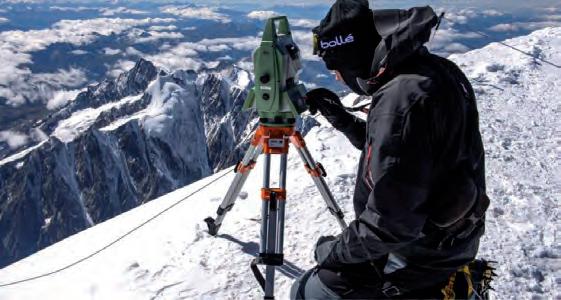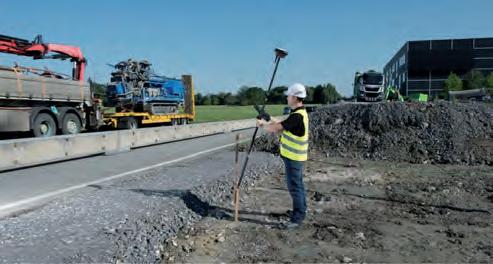
4 minute read
THE EVOLUTION OF THE SMART SURVEYOR
Five Trends Affecting Surveying, Bringing About the Next Generation Surveyor The Evolution of the Smart Surveyor
Surveyors are a versatile and flexible bunch. As the current COVID-19 situation has proven, this group, like others, has had to find new ways of operating. Even this article is an adjustment. Originally planned as a presentation, Sensor Fusion for the Smart Surveyor, for the International Federation of Surveyors (FIG) Working Week 2020, adapting to a new platform for information sharing is becoming the new normal.
In FIG Commission 5 – Positioning and Measurement and FIG Commission 6 – Engineering Surveys, the focus is an everevolving adoption of new technologies and integrating methods with various instruments and sensors to help surveyors, engineers and other measurement professionals to do their job most effectively, whatever the application. As surveyors continue to navigate in these new confines, surveyors will do what they’ve always had to do – adapt, overcome and evolve. As surveyors progress, they become smarter and more efficient. As necessity is the mother of invention, there are driving factors pushing surveyors along the path of evolution. At Leica Geosystems, we are consistently steering and tracking these changes to make our customers more productive while maintaining survey-grade quality and accuracy standards. These are the five most recent trends in the surveying industry, bringing about the next-generation Smart Surveyor.
1. SURVEYORS DO ‘MORE WITH LESS’
While there is plenty of work for surveyors, the average age of surveyors is rapidly increasing. The average age of the professional surveyor in the US, for example, is currently 59 years old. It has become increasingly important to do more surveying with fewer surveyors, and that’s where technology comes in. With a focus on sensor fusion, bringing several sensors into one instrument, more work can be completed with less time and personnel. The Leica Pegasus:Two Ultimate is one such example of sensor fusion technology. With a combination of LiDAR, laser scanning and imagery, the mobile mapping platform increases a working day, enabling surveyors and other measurement professionals to capture reality in a variety of lighting conditions and vehicle speeds. Only with constantly evolving technology are we able to



A recent survey shows 95% of surveyors agree new technologies have made them more efficient.
New technology integrations are making surveyors more productive.
New measurement technologies are democratising surveying.
keep up, making it possible to do ‘more with less’.
2. SURVEYORS ARE MORE THAN JUST SURVEYORS
In the early days of surveying, surveyors could be thought of as pioneers, charting the uncharted. This has changed significantly over the years. No longer are days or weeks required to bring accurate coordinates to new areas; this can now be performed with GPS/GNSS positioning in a matter of minutes, if not seconds. But surveyors need to embrace modern technologies in order to succeed. From business professionals to digital connoisseurs, the modern surveyor now often becomes the data manager, playing an instrumental role in coordinating and managing the digital progression of a project.

3. SURVEYORS ARE EMBRACING THE LATEST TECHNOLOGIES
Preliminary results from an ongoing research project by Leica Geosystems, looking at the needs of surveyors today, reveal 95% of surveyors agree new technologies have made them more efficient at work. Furthermore, research results convey total stations and GPS/GNSS technologies are commonplace with more than 90% utilisation, followed by laser scanning with more than 60% and UAVs with 40% utilisation. This clearly suggests surveyors are embracing the latest technologies. Another interesting finding is on the topic of an ageing profession – more than 50% of the respondents said that they would recommend surveying as a profession to friends/family.
4. THE INTEGRATION OF NEW TECHNOLOGIES IS INCREASING PRODUCTIVITY
At Leica Geosystems, we understand surveyors need to do ‘more with less’ and we are continuing to invest in product development to make our customers more productive. A recent example is the release of the Leica GS18 T, the world’s fastest GNSS rover, that no longer requires the pole to be held vertical. With the integration of an Inertial Measurement Unit (IMU), the tilt of the pole is measured and significantly speeds up the measurement process. Our customers are telling us that productivity increases of more than 20% are being achieved because of this innovation. At the other end of the spectrum, we routinely support the FIG Young Surveyors group and support universities and colleges with the supply of the latest technology equipment and software to be used in their education programmes.
5. TECHNOLOGY IS MAKING SURVEYING AVAILABLE FOR EVERYONE
Surveying is no longer only for university educated professionals. With technology making field work easier, many surveying tasks can be completed by appropriately trained personnel. The professional surveyor will more likely become the data/project manager and a key stakeholder in selecting the correct equipment to get the job done using the personnel available. As the world continues to change, surveyors will continue to evolve. With new technologies consistently coming onto the scene, the opportunities to continually increase efficiency and productivity abound. The resiliency of surveyors in the face of challenges only proves to make the next-generation surveyor smarter.

ABOUT THE AUTHOR
Craig Hill is the vice president of Marketing & Services for the Leica Geosystems’ Geomatics Divisions and Survey Portfolio.





